The 14 Best Harry Potter Scenes, Ranked
Posted by admin on
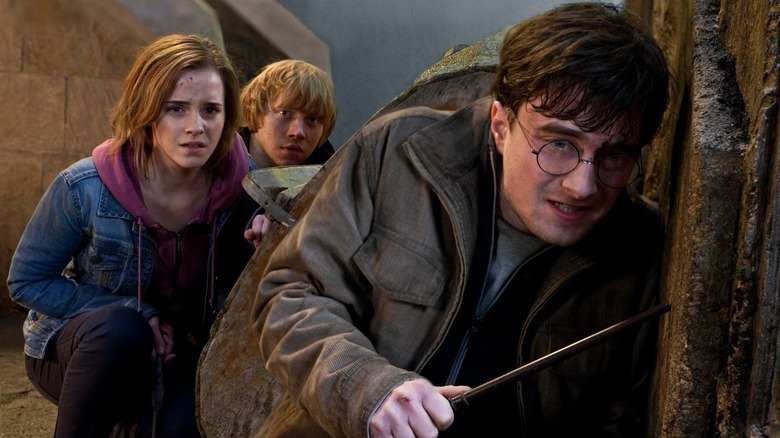
J.K. Rowling's "Harry Potter" series is responsible for getting an entire generation of kids to read. The "Wizarding World" steadily transformed into an expansive universe that claimed fans across the globe. The success of "Harry Potter" is nothing short of miraculous.
The series would not have been nearly as popular if it wasn't for the pivotal casting decisions made for the first film. Casting young actors for any role isn't easy but deciding on the leads for a franchise that will span a decade is almost unthinkable. However, Daniel Radcliffe, Rupert Grint, and Emma Watson couldn't have been more perfect for their roles as Harry, Ron Weasley, and Hermione Granger. The audience got to grow up with these characters as the actors matured.
As the characters grew up, the films became darker. Harry and his friends are forced to stand against evil and oppression when the Dark Lord Voldemort (Ralph Fiennes) rises to power. Although the franchise concluded on a rousing note with 2011's "Harry Potter and the Deathly Hallows: Part 2," fans were invited back to the Wizarding World with the "Fantastic Beasts" prequel series. However, the future of the "Fantastic Beasts" saga is somewhat uncertain. Here are the 14 best "Harry Potter" scenes, ranked.
The Tale Of The Three Brothers, The Deathly Hallows: Part 1
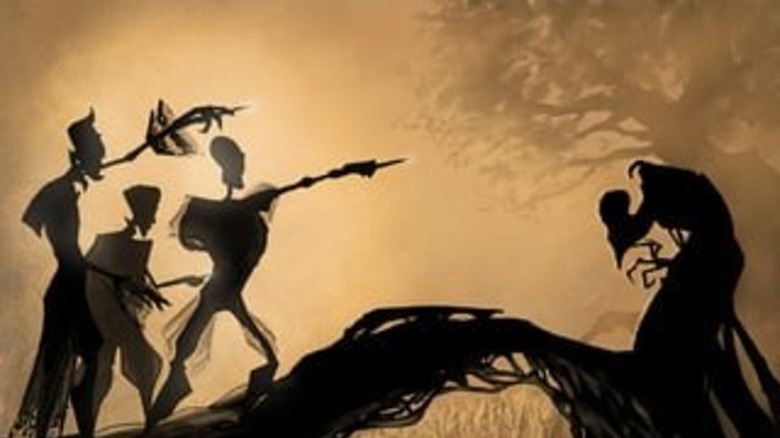
"The Deathly Hallows- Part I" is easily the darkest film in the franchise. Harry begins to learn things about his mentor, Professor Albus Dumbledore (Michael Gambon), that make him reconsider his past. Harry makes a critical discovery about the existence of three items of power: the Deathly Hallows.
Harry, Ron, and Hermione learn about the existence of the Elder Wand, the Resurrection Stone, and the Cloak of Invisibility from Xenophilius Lovegood (Rhys Ifans). It's an intense sequence, as Harry knows that they have little time to process this information and come up with a plan. Director David Yates made an unusual stylistic choice during this scene that granted the franchise one of its most disturbing moments.
As Hermione reads aloud "The Tale of Three Brothers," the prophetic narrative is brought to life in a disturbing animated sequence. It's an eerie way of showing the corrupting nature of power and the dangers of the Elder Wand. This scene raises the stakes of the franchise. If Voldemort has possession of this weapon, then what hope do the heroes have?
Harry Fights The Basilisk, The Chamber Of Secrets
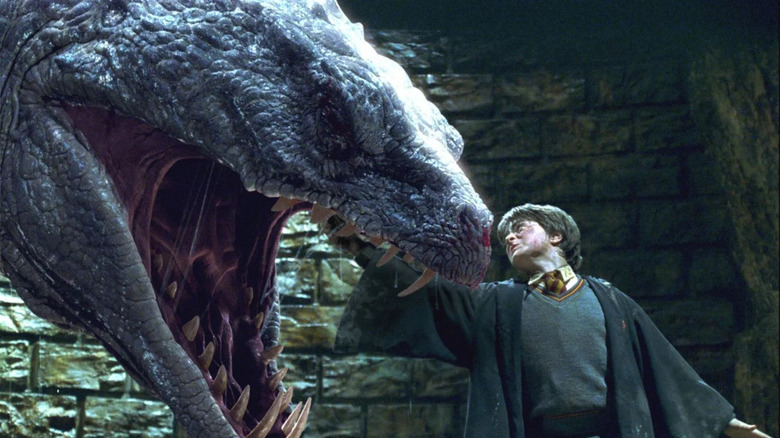
"The Chamber of Secrets" is one of the weaker installments in the franchise. Rowling's original novel is overlong and overstuffed, and director Chris Columbus attempts to cram nearly all of the source material's subplots into his adaptation. While "The Chamber of Secrets" showed that the series was still going through some growing pains, it ends with one of the best action sequences in the saga.
Harry ventures into the Chamber of Secrets to rescue Ginny (Bonnie Wright) from Tom Riddle (Christian Coulson), the manifestation of Voldemort's younger self. To free Ron's sister, Harry must battle the giant snake known as the Basilisk. Harry reaches into the Sorting Hat and receives the Sword of Gryffindor. Considering that the franchise mostly features battles that include magical wands, having a sword in the mix diversifies the combat. "The Chamber of Secrets" is still a children's film, but the Basilisk fight includes some pretty graphic moments.
Harry's bravery pays off. In a touching moment, his wounds are healed by the tears of Fawkes. He also gets to spend a few moments with Ginny, teasing their romance in the later films. With the sluggish pacing of the rest of the film, this action scene concludes "The Chamber of Secrets" on a high note.
The Sorting Hat, The Sorcerer's Stone
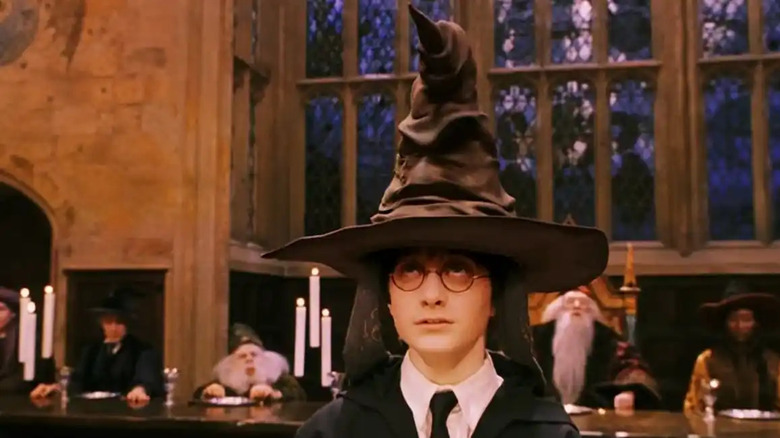
The first installment in the "Harry Potter" series had a lot that it had to get through. Explaining the complex mythology would be one thing, but it was even more important for the audience to invest in Harry as a character. Even if he's a wizard, Harry's anxieties about growing up are very relatable for viewers.
"The Sorcerer's Stone" takes its time introducing the characters to Hogwarts. Harry is wracked with anxiety about which of the four houses he will be sorted into. The scene does a great job at raising the tension as the other characters are assigned to the Gryffindor, Hufflepuff, Ravenclaw, and Slytherin houses. Harry begs the Sorting Hat not to send him to Slytherin. After an extended moment, he is dispatched to Gryffindor. This does a great job of reinforcing Harry's bond with Ron, Hermione, and the other characters that live in their house.
Why is Harry sent to Gryffindor? The next film provides a beautiful explanation. At the end of "The Chamber of Secrets," Dumbledore (Richard Harris) tells Harry that "it is not our abilities that show what we truly are, it is our choices."
Dumbledore's Death, The Half-Blood Prince
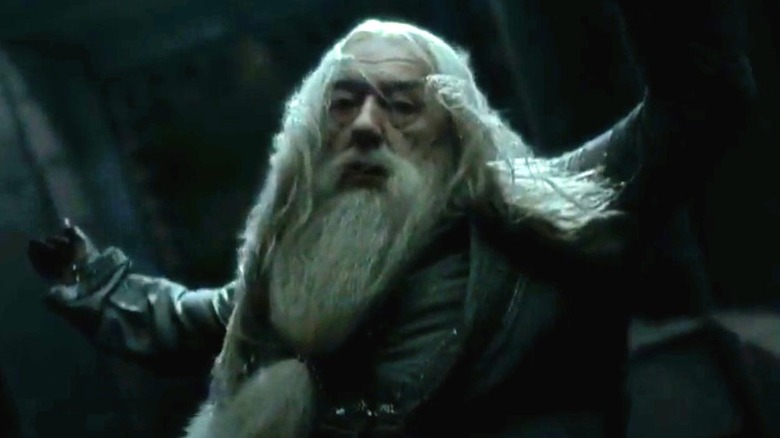
Losing a mentor is an important part of every hero's journey. Harry's life is already filled with tragedy. His parents were killed when he was a baby, he loses his friend Cedric Diggory (Robert Pattinson) in "The Goblet of Fire," and he loses his father-figure Sirius Black (Gary Oldman) in "The Order of the Phoenix." However, "The Half-Blood Prince" includes the most devastating loss yet. Harry is forced to watch as Professor Severus Snape (Alan Rickman) kills Dumbledore.
One of the more compelling aspects of "The Half-Blood Prince" is the characterization of Draco Malfoy (Tom Felton). Although his father, Lucius (Jason Isaacs), is a servant of Voldemort, Draco is just a young man who doesn't know his role in the world. Although Draco is the one selected to kill Dumbledore, he tearfully admits to the Headmaster that he's being forced to. Snape kills Dumbledore to free the poor boy from his burden, even if that's not evident to Harry.
This scene is even more powerful after what we learn later on. Dumbledore and Snape have been working together from the beginning. Dumbledore orchestrated his death. That doesn't make it any less heartbreaking at the moment. The solemn note that "The Half-Blood Prince" ends on sets up an exciting conclusion in the next chapter.
Harry Flies On Buckbeak, The Prisoner Of Azkaban
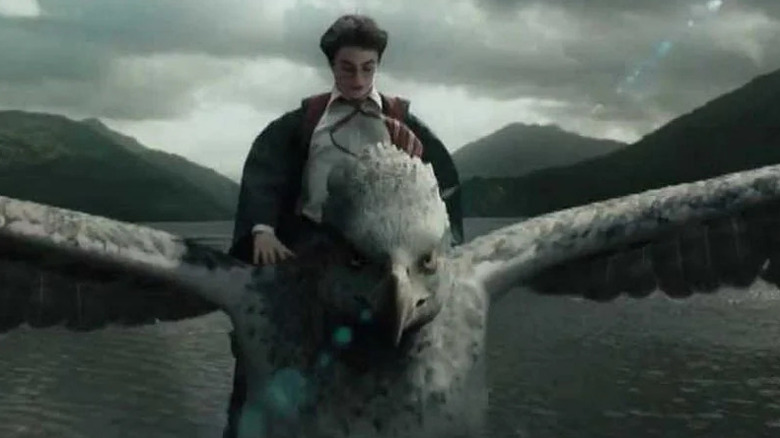
Most "Harry Potter" fans agree that "The Prisoner of Azkaban" is the strongest film in the franchise. The third installment helps transition the series into a more serious saga, and the visual sensibilities of director Alfonso Cuaron make the Wizarding World more exciting. Cuaron is a signature filmmaker who finds a compelling way to capture the earnestness of emotion. Getting Harry's reaction to an authentic moment of wonder is truly magical.
Harry has bonded with the gatekeeper, Rubeus Hagrid (Robbie Coltrane), over their shared love of magical creatures. Although Harry is looking forward to Hagrid's class, he fears that Hagrid may have bitten off more than he can chew. Harry is nervous when Hagrid asks him to fly on the Hippogriff named "Buckbeak." Although he clings on for his life at first, Harry becomes excited after realizing that Hagrid put his trust in the creature for a reason.
It's a gorgeous scene that seamlessly incorporates visual effects. It also sets up a connection between Harry and Buckbeak that pays off when the heroes use time travel to save the poor Hippogriff at the end of the film.
Dumbledore Vs. Voldemort, The Order Of The Phoenix
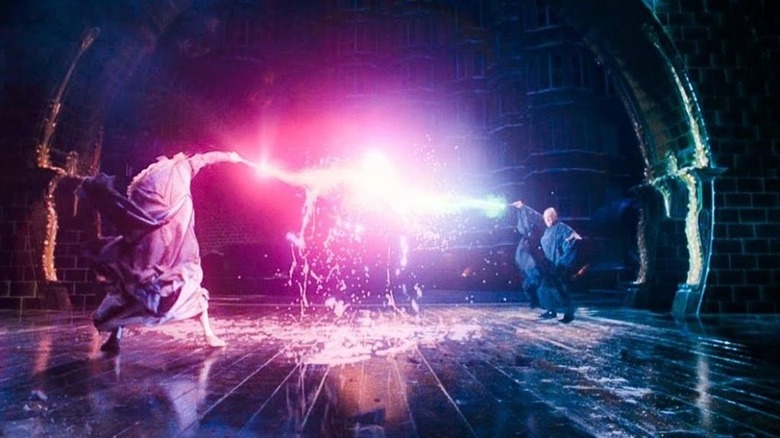
One of the aspects of J.K. Rowling's novels that the films struggled to bring to life is the depiction of wizard conflict. While a novel can go into detail explaining what each spell means and what its effect is, having two actors wave sticks at each other and shout out strange words isn't that visually dynamic. However, "The Order of the Phoenix" manages to make Dumbledore and Voldemort's duel just as exciting to watch as it is to read.
This was the first time that the films took the time to show two wizards battling at the height of their powers. When Harry and Draco duel in "The Chamber of Secrets," they're just two kids that are messing around. Harry's battle with Voldemort at the end of "The Goblet of Fire" is only a brief skirmish. Seeing Dumbledore come in at the last moment to rescue Harry and the other members of the Order is very satisfying. It reinforces Dumbledore's trust in Harry.
Ironically, "The Order of the Phoenix" is one of the weaker novels in the series, but it's one of the best films. Getting an exciting battle during the climax was a great way to end the story on an exciting note.
Cedric's Death, The Goblet Of Fire
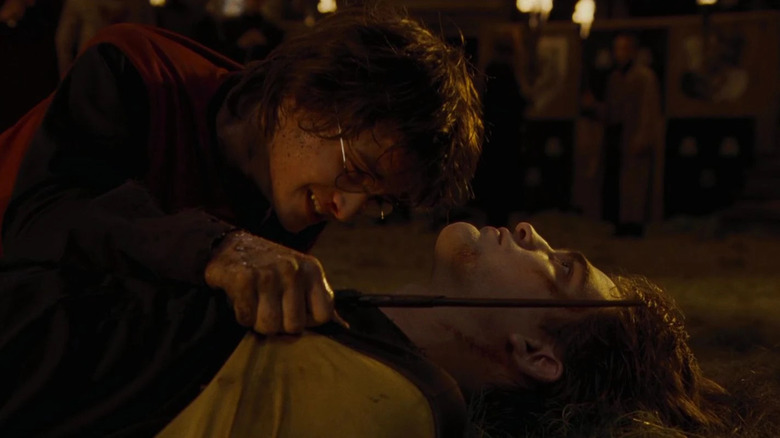
While "The Prisoner of Azkaban" takes the characters in a more mature direction, "The Goblet of Fire" is the film in which the series grows up. It was the first installment in the franchise to receive a PG-13 rating from the MPAA. Harry, Ron, and Hermione face the inherent anxieties of adolescence, but they're forced to grow up a little too quickly when Voldemort returns. Shortly after the Dark Lord is resurrected by his followers, Voldemort murders Harry's friend Cedric Diggory (Robert Pattinson).
Harry and Cedric have an interesting relationship. Although they are expected to be rivals, Harry finds that the popular boy is much kinder than he had expected. Harry and Cedric team up when they escape from the final round of the Triwizard Tournament. Cedric's death strikes a serious blow to Harry. He's never experienced death like this before. While losing his parents when he was an infant was one thing, seeing a boy his own age perish in front of him is something else entirely.
Pattinson left an indelible mark on the franchise, and the tragedy of Cedric's death set the series in a dark new direction. The scene also includes one of the most underrated performances in the saga. Jeff Rawle's performance as Cedric's father, Amos, is devastating.
Harry And Hermione Dance, The Deathly Hallows: Part 1
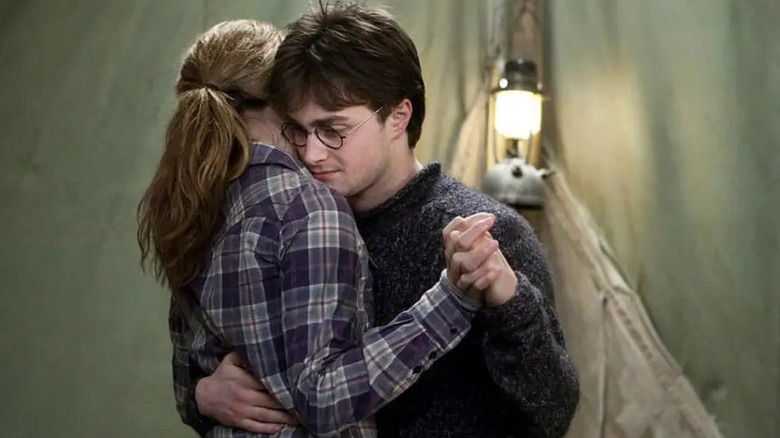
"The Deathly Hallows: Part 1" differentiates itself from the previous installments by placing the characters in the Muggle world. The characters grow further apart as they go on the run. Ron leaves the group after a serious argument with Harry. Although the two have had their disagreements in the past, Ron reaches his breaking point.
Shortly after Ron's departure, Harry and Hermione share a touching moment. They awkwardly dance to the Nick Cave song "O Children" as Harry tries to cheer her up. It's not romantic in the slightest. Even though it is awkward, it's a nice, soothing moment that leaves them both feeling better about their quest moving forward.
John Williams' original score (and Alexandre Desplat's additional compositions) give the franchise some of its most beautiful moments, but they also create a consistent tone. Adding a touch of music outside of the score was a bold change of pace that paid off.
The Quidditch Match, The Sorcerer's Stone
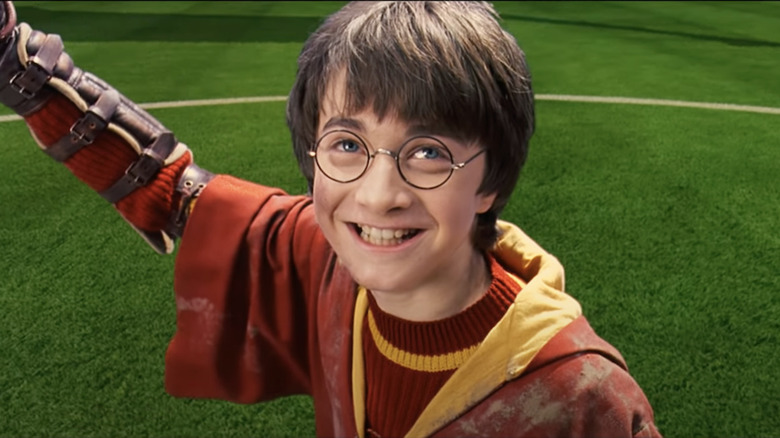
While "The Sorcerer's Stone" is much longer than a standard children's adventure film, it had a difficult balancing act in front of it. In addition to building up the mythology of the Wizarding World and explaining the tragic circumstances surrounding Harry's birth, the film had to proceed as a coming-of-age film about Harry's life on campus.
After a surprising flying lesson, Harry learns that he has a natural aptitude for broomsticks and is selected for Gryffindor's Quidditch team. Harry learns all the nuances of the game from the Gryffindor team's keeper, Oliver Wood (Sean Biggerstaff). The kindness that Oliver shows Harry as he teaches him reinforces the friendship between members of Gryffindor. It also establishes that Harry is keen to impress his new classmates during his first game.
The game is exciting in its own right, but things get even more intense when Ron and Hermione discover that Snape is uttering a spell under his breath. This shows how Harry's friends are supporting him from the sidelines. Ron and Hermione manage to sneak around to stop Snape while Harry claims victory for the team. There's a charming innocence to the sequence that puts it in sharp contrast to the later films in the series.
Harry Builds Dumbledore's Army, The Order Of The Phoenix
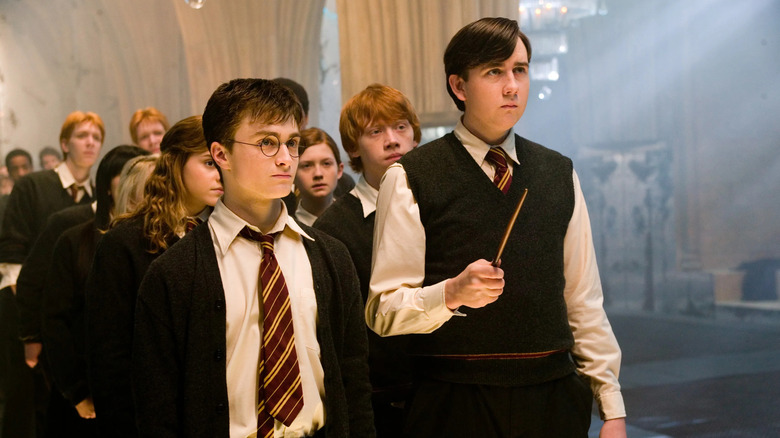
Harry discovers the challenges of the adult world in "The Order of the Phoenix." After the traumatic events of the end of "The Goblet of Fire," Harry is anxious to work alongside the other leaders within the magical world to resist the rise of Voldemort. He is blindsided to find that the Ministry of Magic has denied the existence of the Dark Lord. The Ministry promotes propaganda on the campus of Hogwarts by installing their agent Dolores Umbridge (Imelda Staunton) as the new Defense Against The Dark Arts instructor. Harry grows irritated by the inaction and begins to start growing his own resistance movement.
It was important to show Harry becoming a leader in his own right. While he has faith in Dumbledore and Sirius, he knows that the moniker of "The Boy Who Lived" has stuck with him. Harry is aware of the influence he has on the student population of Hogwarts and uses it to his advantage. To resist both the Ministry and Voldemort's forces of evil, Harry begins secretly training his classmates to become "Dumbledore's Army." It's rewarding to see Harry pass on his knowledge to his friends.
The Flash Forward, The Deathly Hallows: Part 2
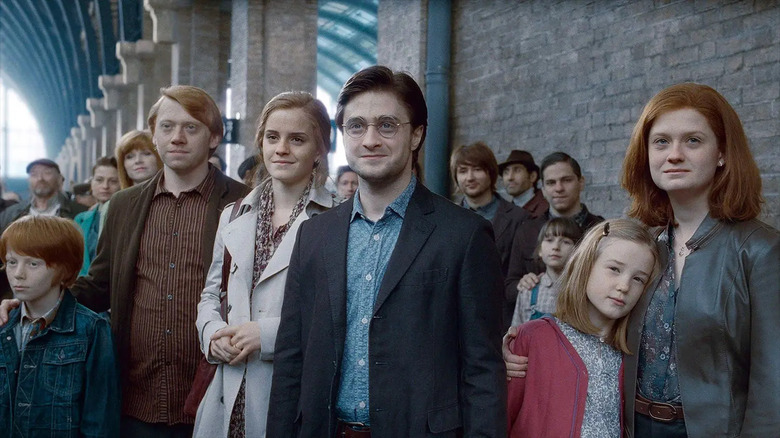
"The Deathly Hallows: Part 2" is a very emotional film for longtime "Harry Potter" fans. Few franchises have dominated popular culture quite like "Harry Potter." "The Deathly Hallows: Part 2" serves as a love letter to the entire series.
In a touching piece of nostalgia, the final scene of "The Deathly Hallows: Part 2" features many callbacks to "The Sorcerer's Stone." Following the conclusion of the Battle of Hogwarts, the film cuts to a title card that reads "19 years later." The film picks up in King's Cross Station, where an older Harry, Ron, and Hermione prepare their children for their first year at Hogwarts. The use of the original John Williams score makes the scene even more touching. Although the makeup effects used to make Radcliffe, Grint, and Watson look older aren't terrific, it doesn't really matter because the emotion is there.
Hagrid Is Welcomed Home, The Chamber Of Secrets
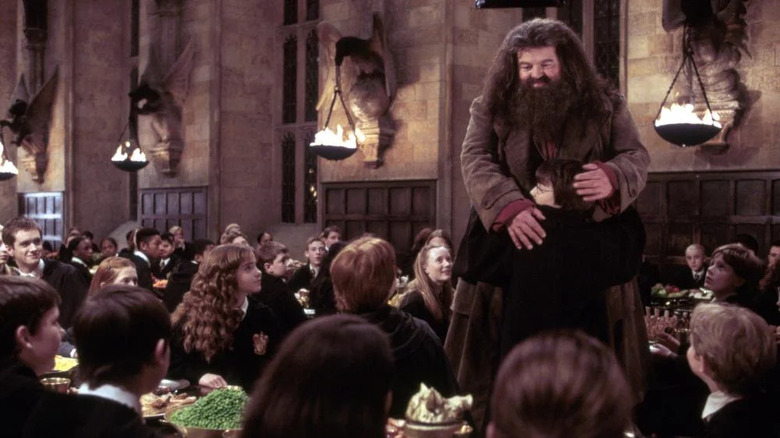
"The Chamber of Secrets" is a much darker film than "The Sorcerer's Apprentice," and Harry must learn to protect his friends in the wizarding community. Hogwarts is overcome with panic as the professors search for the person who has been secretly operating "The Chamber of Secrets." At one point, Hagrid is accused of the crime due to his love of magical creatures. In a heartbreaking scene, Dumbledore, Lucius Malfoy, and Minister of Magic Cornelius Fudge (Robert Hardy) come to arrest Hagrid and take him to Azkaban.
After Harry defeats the Basilisk, he frees Hagrid from suspicion and clears the name of his most loyal friend. During the final scene, Hagrid is welcomed back into the Grand Hall. Harry inspires the other students to begin giving him a round of applause. This reinforces Hagrid's importance in the series and shows the leadership abilities that Harry has. It's a nice, touching moment to end one of the saga's more serious installments.
Harry Vs. Voldemort, The Deathly Hallows: Part 2
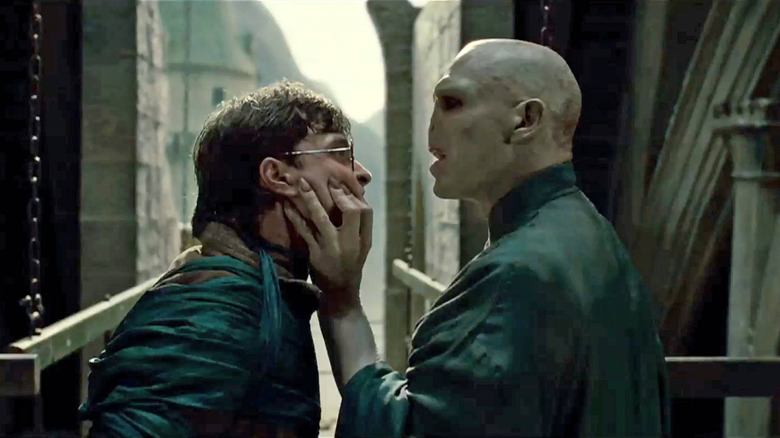
This was the battle that we were all waiting to see. Although Harry and Voldemort had briefly dueled at the end of "The Goblet of Fire," it was only a brief skirmish so that Harry could escape. In the subsequent films, Harry grows more experienced as a wizard, as he must fight for his survival. Both characters' journeys have been intertwined. Voldemort inadvertently created the myth of "The Boy Who Lived" when he killed Harry's parents, and Harry has learned about the Dark Lord as he's searched for the Horcruxes.
Ironically, the battle itself is an instance in which the cinematic version improves upon the source material. While the novel only describes a brief exchange of spells between the two, the film shows a more epic duel in which Harry and Voldemort engage in close-quarters combat. This leads to an exciting standoff in the middle of an open field, where Voldemort finally meets his demise. Slow motion doesn't always work (especially in the "Harry Potter" films) but spending time watching the main antagonist of the series perish is worth it.
Sirius Black's Secrets Are Revealed, The Prisoner Of Azkaban
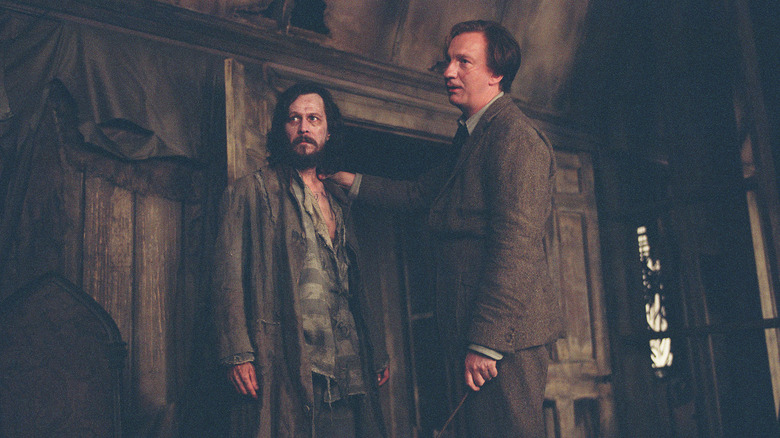
While Chris Columbus deserves credit for helping to launch the young characters on their journey and introduce the world of Hogwarts, it was Alfonso Cuaron and "The Prisoner of Azkaban" that turned the franchise into what it is today. Cuaron pulled off a brilliant balancing act. He was able to include a large amount of exposition without sacrificing pacing. This is particularly evident during a pivotal scene in "The Prisoner of Azkaban" in which Harry learns that some of his assumptions were wrong.
Harry and his friends are cornered by Sirius Black in the passage beneath the Shrieking Shack. Harry has wanted to kill Black for the entire film, as he's been told that the wizard fugitive was involved in his parents' murder. When Professor Remus Lupin (David Thewlis) shows up, he tells Harry the truth. Black is innocent. It's actually Peter Pettigrew (Timothy Spall) — disguised as Ron's rat — who is responsible for the crimes Black has been accused of.
Cuaron brilliantly allows Harry to process the emotional revelations and make quick decisions. Over the course of the sequence, Harry begins to bond with a man that he once thought that he hated. Harry's relationship with Sirius becomes one of the most powerful in the series.
Read this next: 20 Movies About Time Travel Ranked Worst To Best
The post The 14 Best Harry Potter Scenes, Ranked appeared first on /Film.
